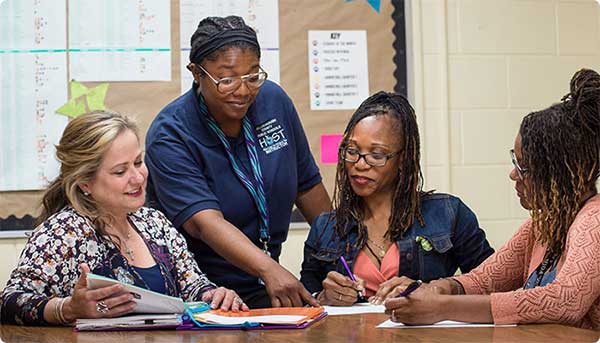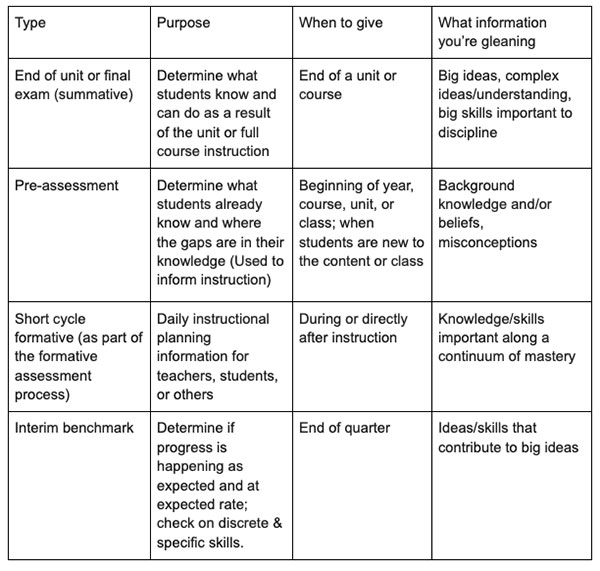April 14, 2022
Assessment and instruction are intrinsically linked. As educators, we know that when we construct high-quality assessments and are strategic in their delivery, we have the right data at the right time to help make better decisions about instruction.
But exactly how do we go about creating assessments that achieve our goals for student outcomes?
The key to success is to begin with the end goal in mind and to then work backward to create the right assessment—a process known as backward mapping. In this blog, I’ll explain how to effectively implement backward mapping for consistency to improve student learning outcomes and create an engaging environment for all students.

What is backward mapping?
Backward mapping, also called backward planning or backward design, is a technique used by teachers that involves setting goals for a lesson, unit, or semester, and then creating assignments and lessons that align with these goals.
When using backward mapping for consistency in education, the teacher begins with the objectives of a unit or course by focusing on what they expect their students to learn and be able to do by the end of instruction. The teacher then proceeds backward to create lessons that achieve their desired goals, as noted above.
In most K–12 schools, the educational goals of a course or unit will be a given state’s learning standards—i.e., concise, written descriptions of what students are expected to know and be able to do at a specific stage of their education.

Example of backward mapping
Let’s say you’re teaching a unit about the American Civil War.
According to state standards, your students should understand the political, cultural, and economic causes of the war, as well as the significance of slavery, state vs. federal rights, the Dred Scott Decision, and the election of Abraham Lincoln in November 1860.
Students also need to understand the importance and impact of people like Lincoln, Frederick Douglass, Ulysses S. Grant, Robert E. Lee, and Harriet Tubman.
Backward mapping for consistency of the Civil War may look like this:
- Assessment: By the end of a unit on the tensions between the North and the South, students will write a letter for or against the war from the point of view of a key player in the conflict.
- Learning: Through direct instruction, group discussions, in- and out-of-class readings, and educational videos, students will become familiar with the issue of slavery, how it affected the lives of the enslaved, what the Underground Railroad was, and the series of events that led to the war.
- Progress: Students will demonstrate their growing understanding of the who, what, when, where, and why of the events of the Civil War through short quizzes, in-class activities, and take-home assignments.
- Outcome: For the final assessment, students will read their letters aloud to the class. If time allows, students may invite responses and engage in debates about their topics.

What is the benefit of using backward mapping?
Backward mapping for consistency helps educators focus on the learning goals throughout the entire teaching process.
The basic rationale of backward mapping is that starting with the end goal of a unit or course—rather than viewing the lessons chronologically—helps teachers to more effectively design a sequence of lessons, problems, projects, presentations, assignments, outcomes, and assessments that result in students learning what they were expected to learn.
The process of backward mapping helps teachers create courses and units that are focused on the goal of learning, rather than the process of teaching.
Because “beginning with the end” is often a counterintuitive process, backward mapping gives educators a structure they can follow when creating a curriculum and planning their instructional process. Advocates of backward mapping believe that the instructional process must serve the goals, rather than the goals—and the results for students—being determined by the process.

6 steps in the backward mapping process
By following these six steps, you can create high-quality assessments that help you to gain the insights needed to inform instruction, delivering the right information at the right time to improve teaching and learning.
#1: Determine the desired outcome(s)
If teams intend to use data to make better instructional decisions, they must ensure they’re choosing the right type of assessment to yield the data they need to achieve the goal of the assessment. This requires having a solid understanding of different assessment types, their purposes, and what they actually measure.
What are you looking to learn from the assessment? This might be to determine what students already know about a topic before you begin the instruction. In contrast, it might be the knowledge and skills students can demonstrate by the end of the unit.
Understanding the desired outcomes will help you to choose the assessment method that’s best suited to measuring these outcomes. Here’s a useful chart that can help you match the assessment type to your desired goals:

#2: Determine standards and learning targets
Knowing the goal or purpose of the assessment is the first step in backward mapping. The next step is to determine the standards and learning targets you want to assess.
Learning targets describe the specific evidence that you’re trying to measure. We know that some standards are written using fairly broad language. We have to unpack the standards so that we can meaningfully assess them. What knowledge, skills, or abilities do students need to demonstrate?
When you identify learning targets, it can be especially helpful to do this with your students in mind. Look at your priority and supporting standards, and rewrite them in language that your students will understand. This helps the learning targets become more accessible to and attainable by the students.

#3: Evaluate the rigor of standards and learning targets
The next step is to identify the level of rigor for the learning targets you’re looking to assess. Work as a team to unpack the complexity and difficulty of the learning target.
There are different models to describe cognitive rigor, such as Bloom’s Taxonomy and Webb’s Depth of Knowledge. You can use these models to help you determine the rigor of the learning targets.
#4: Match the assessment to the desired outcomes, learning targets, and level of rigor
Once you’ve determined the rigor of learning, it’s time to choose the assessment method that best matches your desired outcomes. Choose or create assessment item types (e.g., multiple choice, constructed response, EBSR, etc.) and questions that match the learning targets and level of rigor you’re aiming to measure.
#5: Create the assessment blueprint
Develop a map of your entire assessment, so you know exactly how to build it. This step connects the dots between learning targets, depth of knowledge (DOK), assessment methods, and items.
Decide which formative assessment strategies will be used to check for understanding and progress throughout the unit. You may decide to implement:
- A pre-class open-ended question, asking students what they learned in the last class session
- A live multiple-choice poll that asks students about what you’re currently teaching
- A short, end-of-class survey to discover whether students found the information to be interesting, challenging, and/or enjoyable to learn
- A quick Word Cloud where students provide a short or one-word answer to your question about learning content

#6: Generate or select the test items and/or tasks
The final step in backward mapping is to use your blueprint to select or create the right items for your assessment.
DnA by Renaissance makes it easy to ensure success for all students by allowing teachers to create standardized assessments and actionable reports that accelerate learning.
With DnA, you’ll have…
- Thousands of standards-aligned, high-quality items in core subject areas
- Instant scoring
- Formative feedback; and
- Interactive reporting
…that will help you gain the clarity you need to understand where your students are in the learning process and guide instructional practice to improve learning outcomes.
Learn more
Connect with an expert today to learn more about DnA and other solutions from Renaissance built for today’s classrooms.

